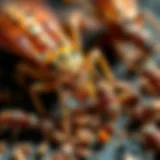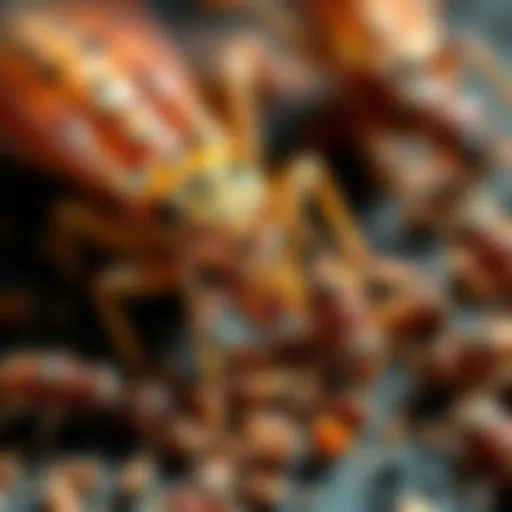Effective Possum Removal Strategies for Your Attic
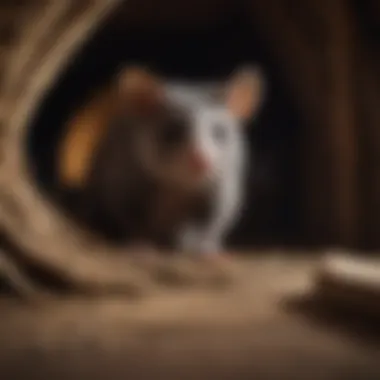

Intro
Dealing with a possum in your attic can be a stressful experience. These creatures, while generally harmless, can cause significant damage and health risks if left unaddressed. Understanding how to identify these pests, the methods to prevent them from entering your home, and the effective strategies for removal are crucial for any homeowner. This guide aims to equip you with knowledge about possum behavior and the steps to regain control of your living space.
Pest Identification
Understanding how to correctly identify a possum is the first step in addressing an infestation.
Detailed descriptions of common pests
Possums are marsupials native to Australia and New Zealand, often appearing gray with a white face. They are about the size of a domestic cat, featuring a long, hairless tail and large eyes. When threatened, a possum may play dead—a behavior that can mislead homeowners into thinking the problem is resolved. Notably, possums are nocturnal, making them more active at night.
Signs and symptoms of infestations
It can be concerning if you suspect a possum has made your attic its home. Common signs of an infestation include:
- Noises in the attic or walls during the night, often described as scrabbling or scratching.
- Presence of droppings similar to those of a domestic cat, which may appear in areas like your attic or around entry points.
- Chewed wires, insulation, or other materials indicating nesting behavior.
- Foul odors due to waste accumulation or the presence of a sick possum.
Prevention Strategies
Preventing a possum from entering your attic requires diligence and attention to common entry points.
Home maintenance tips for pest prevention
Simple maintenance tasks can make a significant difference. Consider the following:
- Seal Entry Points: Inspect your home for gaps or holes around pipes, vents, and the roof. Use materials like steel wool or caulk to seal these areas.
- Trim Trees and Shrubs: Ensure branches do not provide easy access to your roof. Keep vegetation trimmed away from your home.
- Remove Food Sources: Store food properly and secure trash bins. Possums are attracted to easy food access, so keep yards clean and free from fallen fruits or pet food.
Natural deterrents and barriers
Incorporating natural deterrents can also assist in keeping possums at bay:
- Motion-Activated Lights: These devices can startle possums and discourage their presence.
- Essential Oils: Some homeowners report success using strong scents like peppermint or eucalyptus near entry points, as possums are sensitive to odors.
Treatment Options
If you've confirmed a possum infestation, you’ll need effective treatment options to remove them humanely.
Overview of chemical vs. natural treatments
When considering treatment options, the choice between chemical and natural methods depends on your preferences and local regulations. Chemical poisons are often lethal, which raises ethical considerations. In contrast, natural methods focus on humane removal and deterrence. Consulting local wildlife control can provide insight into safe practices.
Step-by-step guides for DIY treatments
For a more hands-on approach, here are some DIY removal options:
- Humane Traps: Purchase traps designed for possums, following manufacturer instructions. Bait the traps with fruits or peanut butter.
- Relocation: Once trapped, contact wildlife services for advice on relocating the possum safely and legally.
- Safe Release: Ensure the area where you release the possum is geographically appropriate and has food sources available to support its survival.
Important Note: Always check local laws regarding wildlife removal. Some areas have specific regulations for trapping and relocating possums.
By using these insights, homeowners can effectively tackle a possum problem and restore peace to their homes.
Understanding Possums
Possums are nocturnal marsupials that often find unwelcome shelter in attics. Understanding their biology and behavior is crucial for homeowners dealing with an infestation. This knowledge allows for effective strategies in removal and prevention. It helps to appreciate why possums are drawn to certain environments and how they can be managed without harm to the animal.
Knowing details about a possum's lifestyle can inform decisions on how to address the situation. When a homeowner understands these creatures well, it can guide practical and humane approaches to removal, which is essential for both the animal and the property owner.
Biology and Behavior
Possums have distinct biological traits that influence their behavior. They are marsupials, meaning females carry their young in pouches. An adult possum generally measures about 24 inches in length, including a tail. Their fur is gray to black in color, featuring a white face and pointed ears. They are particularly adept at climbing, making attics an ideal shelter.
Possums are typically solitary animals. They are not aggressive and tend to avoid confrontation, often playing dead when threatened. This behavior aids in their survival, as many predators are deterred by this display. Their diet is omnivorous, consuming fruits, insects, and smaller animals. This adaptability makes them resilient in urban environments. Their nocturnal habits mean they are most active at night, which can lead to disturbances in quiet homes.
Common Attic Habits
Once a possum infiltrates an attic, its habits can cause various issues. Possums can create noise during the night, leading to sleep disruptions for residents. They often build nests in hidden areas, utilizing insulation or other materials found in the attic. This can result in substantial mess and potential damage.
Possums are also known to explore their surroundings extensively. They will chew on electrical wires and insulation, creating not only a nuisance but also a fire hazard. Leaving food remnants can attract other pests, compounding the problem.
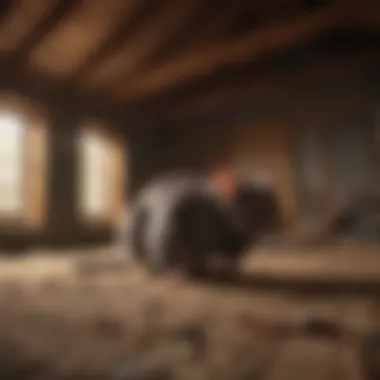

"It is important to address a possum infestation promptly to minimize damage and risks associated with their habits."
The signs of possums in an attic can include sounds such as scratching or scurrying, and physical evidence like droppings. Awareness of these factors can help a homeowner take timely action.
Signs of Possum Infestation
The detection of possum infestation is a critical step in addressing the issue effectively. Identifying the signs early enables homeowners to take appropriate action before the situation escalates. Possums are nocturnal creatures and may cause significant damage if they reside in your attic for an extended period. It is essential to recognize both visual and auditory cues, along with physical evidence that can confirm their presence.
Visual and Auditory Cues
When it comes to spotting signs of a possum infestation, visual and auditory cues play a crucial role. This includes looking for unusual activity during the night, as possums are most active after dusk.
Visual cues may include:
- Scattered insulation materials, often appearing displaced or chewed.
- Droppings that resemble those of a cat but are more elongated and can be shiny or moist.
- Grease marks or smudges along surfaces where the possum has traveled, typically near entry points.
- Nesting materials that could consist of leaves, grass, or other debris brought into the attic.
In addition to visual signs, listening for specific sounds can also indicate a possum's activity. This can include faint scratching noises or thumps as they move about. If you hear noises coming from your attic during the night, it is advisable to investigate further.
Physical Evidence
Physical evidence is another way to confirm that a possum has taken up residence in your attic. Such evidence can often provide insight into the level of infestation.
Common physical signs include:
- Possum droppings, which can pose health risks. It's key to differentiate these from those of other animals.
- Scratches on wood or other surfaces from the possum's claws. These can indicate where they have been climbing or scratching.
- Burrow holes or pathways leading to or from the attic. Observing these entry points is essential for understanding how they are accessing your home.
- Damage to roofing or siding, which could be a sign of an attempt to introduce themselves into the living space.
Effective early detection can significantly minimize the risk of health issues and property damage associated with possum infestations.
Recognizing the signs of infestation not only provides the basis for removal but also aids in preventing future occurrences. Once confirmed, timely action is necessary to mitigate the potential risks that possums bring, ensuring a safe and secure home environment.
Potential Risks Associated with Possums
Understanding the risks linked to possums is crucial for homeowners. These creatures, while generally less aggressive than other pests, can pose significant hazards if they take up residence in your attic. From health risks to structural issues, recognizing these dangers can help you make informed decisions about possum removal and prevention strategies.
Health Risks to Humans and Pets
Possums may be perceived as harmless, but they can carry diseases that are of concern to both humans and pets. One of the most notable health risks is leptospirosis, which can be contracted from contact with urine or feces of infected possums. Symptoms in humans include fever, chills, and muscle aches. For pets, particularly dogs, the risks are just as real. Pets can become ill if they encounter the urine or consume infected possum carcasses.
Additionally, possums can host parasites such as fleas, ticks, and mites, which can easily transfer to your pets or home. Preventive measures include keeping your yard clean and ensuring that pets are kept up to date with their vaccinations. Regular check-ups with a vet can help catch any potential issues early, reducing long-term health risks.
Structural Damage to Property
In addition to health risks, possums can cause significant structural damage to your home. Their presence in an attic can lead to several issues:
- Gnawing and Chewing: Possums may gnaw on wiring, insulation, and wooden beams, leading to expensive repairs.
- Nesting Materials: They often use insulation and other materials to build nests, which can degrade your insulation's effectiveness.
- Droppings and Urine: This waste can lead to moisture problems, fostering mold growth that affects the air quality of your home.
Ultimately, the costs of repairing damage caused by possums can outweigh the benefits of addressing the infestation promptly. Homeowners need to be vigilant about signs of possum activity to mitigate these risks before they escalate.
"Recognizing the potential risks tied to possums is a proactive step toward ensuring the safety of your home and family."
By acknowledging these dangers, you will be better prepared to take action if a possum infestation arises.
Legal Considerations
Understanding the legal framework surrounding wildlife removal is critical for homeowners confronting a possum infestation. Ignoring these laws can lead to significant consequences, including fines and legal actions. It is essential to know local wildlife protection laws and the permits necessary for possum removal. By following these regulations, homeowners can engage in responsible actions while protecting their property and adhering to the law.
Local Wildlife Protection Laws
Every state or region has specific wildlife protection laws that safeguard certain animal species from harm. For instance, in many areas, the opossum is classified as a protected species. It is important to check with local wildlife agencies to understand the laws applicable in your region. This knowledge helps you avoid any unintentional violations.
Homeowners may face legal implications if they attempt to harm or kill possums without proper authority. The consequences can vary from fines to more serious penalties. Moreover, some states require that any possum removal must be done humanely and in compliance with established protocols. Therefore, consulting resources such as your local wildlife authority or Britannica is beneficial to stay informed.
Permits for Removal
In many jurisdictions, handling possums may require specific permits. Before initiating any removal process, it is prudent to verify whether a permit is needed for your situation. This requirement may depend on several factors, including the method of removal and the population of possums in your area. Some regions also mandate that any traps used must adhere to safety and humane guidelines.
Obtaining the necessary permits often involves filling out applications and paying a fee. This process may seem cumbersome, but it is an essential step to ensure compliance with local laws. Permits ensure that possum management is conducted ethically and sustainably.
"Always confirm local regulations before taking action against wildlife. Ignorance of the law is not a defense."
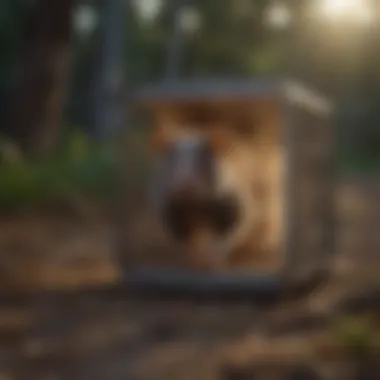

In summary, knowing local wildlife protection laws and securing permits are vital when dealing with possums in an attic. These steps ensure that homeowners address wildlife issues lawfully and responsibly, minimizing risks associated with unauthorized actions.
Preventive Measures
Preventive measures are crucial in addressing the issue of possums in your attic. Understanding how to keep these animals at bay can save homeowners from extensive damage and stress. By acting proactively, you can effectively limit the opportunities for possums to invade your living space. Prevention not only protects your property but also safeguards your family and pets from potential health risks associated with possum infestations.
Sealing Entry Points
One of the primary strategies in preventing possums from entering your attic is sealing potential entry points. Possums can squeeze through surprisingly small gaps due to their flexible bodies. Common areas to inspect include:
- Gaps around windows and doors
- Holes in the roof or eaves
- Vents and exhaust fans
Start by conducting a thorough inspection of your home. Look for any cracks or openings that could serve as an entry point. Use materials such as steel wool or hardware cloth to seal small holes. In case of larger openings, consider using plywood or other sturdy materials that can withstand attempts to open them.
"An ounce of prevention is worth a pound of cure. Sealing entry points is an investment in your peace of mind."
Removing Attractants
Another essential tactic in your preventive strategy is removing attractants that may draw possums into your environment. Possums are opportunistic feeders; therefore, making your home less appealing to them is vital. Here are some steps you can take:
- Store food securely: Keep pet food indoors and seal trash in hard bins.
- Maintain gardens: Clear fallen fruit, leftover pet food, or compost that could attract possums.
- Eliminate water sources: Fix leaks and remove standing water to dissuade possums from taking up residence.
Creating an uninviting environment is key to discouraging these nocturnal visitors. Regular maintenance and awareness of their habits will significantly reduce the likelihood of an infestation. By prioritizing preventive measures, you can maintain a peaceful and safe living space.
Humane Removal Techniques
Humane removal techniques are essential when dealing with a possum inhabiting your attic. These methods not only ensure the ethical treatment of wildlife but also align with legal regulations regarding animal removal. Possums play a role in the ecosystem, controlling pests and enriching soil. Thus, it is vital to approach the removal process with care and respect.
Using humane methods minimizes stress for the animal and reduces the risk of injury. Additionally, following these techniques often results in successful removal without causing harm to the possum or damage to your property. Understanding these methods will empower homeowners to take appropriate action while maintaining compassion for the creature.
Trapping Methodology
Trapping is one of the most common humane techniques for possum removal. It involves using traps specifically designed for capturing animals without causing them harm. The first step is selecting the right type of trap. A cage trap works well, as it can securely contain the possum without inflicting injury. Look for traps that comply with standard safety measures.
Here are some key points to consider:
- Select the Right Size: The trap should be spacious enough to hold the possum comfortably.
- Baiting the Trap: Use fruits such as apples or grapes as bait. Possums are attracted to sweet foods.
- Placement of Trap: Set the trap in areas where you notice signs of possum activity. Typically, this will be near entry points or feeding spots.
- Check the Trap Regularly: Monitor the trap frequently to ensure the possum does not remain trapped for an extended time. This is important for both the animal's welfare and your own peace of mind.
Safe Relocation Practices
Once a possum is trapped, the next step entails safe relocation. It is important to transport the animal in a way that protects it and ensures its survival after release.
Here is how to handle the relocation process:
- Choose an Appropriate Location: Release the possum at least five miles away from your home in a suitable habitat, preferably where it can find shelter and food.
- Time of Release: Opt for early morning or late evening for the release, as these are times when possums are naturally active.
- Avoid Direct Handling: Minimize contact to prevent stress for the animal. Instead of opening the trap yourself, allow the trap to rest on the ground in the chosen location and open the door without direct interaction.
- Observe Local Guidelines: Be aware of local wildlife regulations regarding the relocation of animals to ensure compliance.
By following these humane removal techniques, homeowners can effectively address possum infestations while respecting the creature's role in nature and adhering to legislation protecting wildlife.
Professional Assistance
When dealing with an infestation of possums in your attic, the decision to seek professional assistance becomes increasingly important. These creatures can pose various challenges not just in removal, but in ensuring the safety and well-being of both the animals and your household. The expertise offered by pest control professionals is often indispensable. They understand the behavior of possums and are trained to deal with them effectively while adhering to local regulations.
There are several key benefits to engaging professionals for possum removal. First, they possess specialized tools and techniques that are often not accessible to the average homeowner. This can lead to more effective and targeted removal strategies. Additionally, professionals typically have knowledge of safety hazards associated with wildlife infestations, ensuring safe approaches that reduce the risk of injury.
Furthermore, professional pest control services often provide follow-up measures. They can help to identify potential entry points and recommend modifications to prevent future infestations. Their experience allows them to share insights into maintaining a possum-free environment, which is vital for long-term peace of mind.
"Hiring a professional not only addresses the current problem but also helps prevent future encounters with wildlife."
When to Call an Expert
Knowing the right time to reach out to a pest control expert can make a significant difference in effectively managing a possum problem. If the signs of possum presence are persistent—such as unusual noise, droppings, or your pets showing signs of distress—it's prudent to consider professional help immediately.
Additionally, if attempts at humane trapping fail, or if you are unsure how to execute safe removal, engaging an expert becomes even more critical. An infestaton that goes untreated for too long can lead to increased property damage and health risks, making prompt professional intervention essential.
In some cases, local wildlife laws may mandate that certain animals be handled by licensed professionals, especially if relocation is necessary. If you find yourself uncertain about regulations in your area, this is another signal that expert assistance is needed.
Choosing a Reliable Pest Control Service
Selecting a reliable pest control service involves several important considerations. First, research the company’s reputation through reviews and testimonials on platforms such as Facebook and Reddit. Look for services that have experience specifically handling wildlife, as they will be better equipped to address possum-related issues.
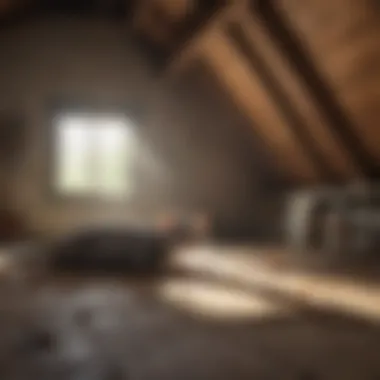

Ask potential pest control services about their methods for humane removal. A responsible company will prioritize ethical treatment of the animals. Moreover, verify that the service is licensed and insured, as this protects you from liability in case of any accidents during the removal process.
Additionally, inquire about follow-up services provided. It is beneficial to have an ongoing relationship with the pest control team to safeguard your property from future infestations. Ultimately, making an informed choice about professional assistance is key to effectively managing possum removal and ensuring a safe living environment.
Post-Removal Considerations
Once a possum has been safely removed from your attic, it is crucial to engage in post-removal considerations. This step is often overlooked, but it plays a vital role in ensuring that the problem does not recur. By focusing on thorough inspections and maintaining an environment that discourages future intrusions, homeowners can effectively safeguard their properties against further infestations. This section highlights two key aspects: inspecting entry points and maintaining an uninviting environment.
Inspection of Entry Points
Conducting a detailed inspection of your attic and the surrounding areas is essential after removing a possum. This inspection helps identify any potential entry points that the animal may have used to infiltrate your space. Common areas to check include:
- Roof vents and chimneys
- Gaps around plumbing pipes
- Holes in eaves or soffits
- Openings created by deteriorating shingles
Utilizing materials like steel mesh or hardware cloth, you can seal these entry points effectively. Not only will this help in keeping possums out, but it may also deter other pests. Additionally, while inspecting, it becomes vital to examine for signs of damage or remains in the attic, which may suggest other animals or further risk to your home. By ensuring that your attic is sealed off properly, you minimize the likelihood of future infestations.
Maintaining an Uninviting Environment
After handling the removal, it is essential to create an environment that is largely unattractive to possums and similar wildlife. This can be achieved through various strategies:
- Remove food sources: Ensure that you do not leave pet food or leftover scraps lying around, indoors or outdoors. Secure trash bins tightly and compost in rodent-proof containers.
- Limit shelter options: Trim back any vegetation near your home. Overhanging branches can provide easy access to your attic while dense shrubs may offer hiding spots for possums.
- Lighting: Installing motion sensor lights around your property can also discourage nocturnal creatures like possums from coming nearby. They are generally skittish and prefer dark, secluded areas.
By implementing these strategies, you not only reduce the possibility of possum return but also create a less inviting atmosphere for other pests. Regular maintenance and vigilance can greatly assist in keeping your home pest-free.
"An ounce of prevention is worth a pound of cure."
This saying rings especially true when considering wildlife management in residential properties.
Educational Resources
Understanding how to effectively manage a possum infestation involves more than just immediate action. Educational resources serve as a vital means to equip homeowners with knowledge about possums, their behaviors, and effective removal strategies. Not only do these resources provide foundational insights, but they also emphasize the importance of humane practices in wildlife management. Moreover, they help distinguish between various local laws regarding wildlife, which is crucial for legal compliance. Investing time in educating oneself about these creatures enhances one’s ability to prevent future infestations and address them responsibly when they do occur.
Books and Online Materials
Books and online materials can be an invaluable resource for anyone facing the challenge of removing a possum. They often encompass not only methods for removal but also delve into the ecological significance of possums. For instance, books like "Possums: The Complete Guide to Their Care" provide detailed information on possum behaviors, potential health concerns, and the best humane practices for removal. Many online platforms also offer e-books and guides that are accessible anytime.
Some recommended online materials include:
- Academic articles on wildlife studies, accessible through platforms like Google Scholar.
- Online forums such as Reddit, where homeowners share experiences and solutions.
- Educational websites like Britannica that explain possum biology and their role in the ecosystem.
These resources encourage a balanced understanding and foster a more respectful approach to nature.
Local Wildlife Conservation Groups
Local wildlife conservation groups are essential partners in addressing possum-related issues. These organizations often provide support, guidance, and resources on humane possum removal. By contacting such groups, homeowners can gain access to professional insight into local laws and the ethical implications of wildlife management.
Many groups offer the following:
- Workshops on wildlife coexistence strategies.
- Expert advice on possum behaviors and ecology.
- Resources for finding humane traps and relocation guidelines.
Engaging with local conservation groups also emphasizes community responsibility. When people collaborate for the protection of wildlife, they cultivate a more tolerant view of urban wildlife presence. This cooperative approach is more sustainable and promotes coexistence rather than conflict.
"Educating oneself about the local wildlife fosters a deeper respect and understanding, which is crucial for both humans and animals."
Frequently Asked Questions
Addressing the concerns of homeowners dealing with possums in their attics is essential. This section serves as a resource for those seeking clarity on common doubts and queries. Understanding frequently asked questions can significantly ease the anxiety of dealing with a possum invasion. It can also provide helpful insights that might not be covered in other sections.
Common Misconceptions
Possum infestations often come with a veil of misunderstandings. Many people believe that possums are aggressive or will invade homes aggressively. This is not true; possums are generally timid creatures. They prefer to avoid confrontation and will likely flee when disturbed. Another misconception is that possums carry rabies. Their body temperature makes it unlikely for them to carry this virus. Awareness of these misconceptions helps homeowners manage their expectations and responses better.
Some prevalent myths include:
- Possums are dirty: In reality, they often help clean their environment by consuming pests like ticks.
- They are a pest: They are vital to the ecosystem, acting as scavengers.
Being aware of these misconceptions allows homeowners to handle possum-related issues with a more informed perspective.
Practical Advice
When faced with a possum in the attic, it is crucial to approach the situation with a calm mindset. Firstly, assess the situation to determine if the possum is indeed inhabiting the attic. Listen for noises during the night when possums are active. If confirmed, utilize safe removal strategies. Avoid harmful traps or toxic substances; instead, opt for humane traps that catch the possum without causing harm.
Here are some practical steps:
- Locate entry points: Identify how the possum gained access to the attic.
- Seal entry points: Once removed, secure these openings to prevent future invasions.
- Clear out attractants: Remove food sources or anything that could entice possums to your property.
Regularly inspect your attic for signs of animals and make it unwelcoming. This knowledge not only helps with possum removal but can also aid in preventing similar problems in the future.


